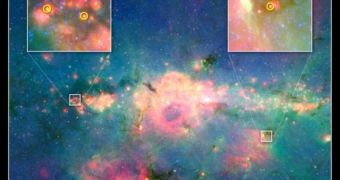Astronomers using the Spitzer Telescope for stellar observations have recently discovered three new stars at the core of the Milky Way, which live in a particularly harsh environment. Outer space, as a whole, is not the friendliest neighborhood to live in, but the conditions that these stellar formations bear are beyond comprehension. Other than the black holes lurking in the area, fierce stellar winds and shock waves make for an unsuited place for stellar formations. However, these little ones seem to get along just fine.
“It is amazing to me that we have found these stars. The galactic center is a very interesting place. It has young stars, old stars, black holes, everything. We started mining a catalog of about 1 million sources and managed to find three young stars – stars that will help reveal the secrets at the core of the Milky Way,” NASA’s Exoplanet Science Institute head researcher Solange Ramirez, from the California Institute of Technology (Caltech), explains.
The discovery was announced at the 214th semi-annual meeting of the American Astronomical Society meeting, currently being held in Pasadena, California. Until now, researchers have known that young stars need to be able to gather enough mass and chemicals from their surrounding gas and dust clouds, which they would then ignite and start nuclear fusion, the process that gives them brightness and the ability to heat up their surroundings. The new formations, which were observed using Spitzer's powerful infrared sensors, seem to be managing that despite their environment.
The astronomers noticed that all three of them showed signs of acetylene, hydrogen cyanide and carbon dioxide, all chemicals that are formed when the new stars start heating up the gas and dust around them. This means that they were just formed, and experts can say that for sure, because our galactic core, just 600 light-years across, is the only one they can get a good look at. However, most of it is enveloped in large amounts of dust, which means that optical telescopes cannot resolve anything inside it.
“The Milky Way galaxy is just one of more than hundreds of billions of galaxies in the visible universe. However, our galaxy is so special because we can take a closer look at its individual stellar components,” Caltech Infrared Processing and Analysis Center expert Deokkeun An concludes. He is also the lead author of a new paper detailing the finds, which will appear in an upcoming issue of the scientific publication Astrophysical Journal, Wired reports.

 14 DAY TRIAL //
14 DAY TRIAL //